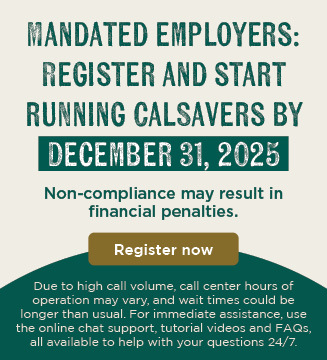Submitting Contributions
This is the final - and most important - step in your employee’s ability to save for retirement. In this step, you will send your employee’s payroll deductions to CalSavers so that the amount can be applied to their retirement savings account and invested according to their instructions.
When should this step be completed?
- First time: You should plan to send payroll contributions for any participating employees on the first pay date that occurs 30 days after you uploaded your employee information. For more information on how to identify eligible employees, watch this short video.
- Ongoing: As employees make changes that impact their contribution amount, notifications will sent to you by e-mail and posted in the Employer Portal prior to each pay period. You will continue to send employee contributions each pay period until the employee leaves your company or opts out of participation.
Important: Contributions must be sent within 7 days of taking the money out of your employees’ paychecks.
Information you will need to complete this step:
Before you can submit contributions, you’ll need to establish the payroll deduction within your bookkeeping or payroll software/file.
You will also need:
- The contribution amounts each employee selected. Found on the Employee Dashboard page.
- Bank information to execute an electronic bank transfer of funds. (Note: you can also send paper checks.)
What comes next?
You will continue to send employee contributions each pay period until the employee leaves your company or opts out of participation.
Frequently asked questions
No. Employers are not allowed to make contributions on behalf of, or as a match to, employee contributions in this program. If an employer wishes to make contributions to a retirement plan on behalf of their employees, they should explore offering an employer-sponsored retirement plan.
It is the responsibility of program participants to monitor their own annual contribution limits across all Individual Retirement Accounts (IRA) they maintain, including their CalSavers account. CalSavers intends to notify employees when their CalSavers account is close to reaching the federal annual contribution limits for an IRA and will instruct employers to stop contributions when employees’ contributions reach the limit. Note that limits apply across all IRAs maintained by an individual and CalSavers will not know of other IRAs that program participants maintain elsewhere.
It is also the responsibility of the program participant to determine if they are eligible to contribute to a Roth IRA, and to comply with any other IRA rules. However, CalSavers will provide program participants with educational materials to help participants understand the rules.
Employees are invited to enroll in the CalSavers program for each employer that they work for. They may choose to opt out of contributions through an employer or contribute through multiple employers at the same time. Program participants must monitor their contribution levels across all of their IRAs to ensure they do not violate IRS limits.
If an employee decides to opt out after their account has already been funded they have the option to request a withdrawal in the form of a check or bank transfer. If this occurs, employees should be referred to the web site to complete a Withdrawal Form or contact the Client Services Team at 855-650-6918.
An employee’s contribution rate can be set for less than 5%, but it does need to be a whole percentage. When employees make contribution rate changes, you will be notified prior to your next pay date and must make the necessary adjustment on their payroll deduction
The portal does not allow employers to change employee contribution rates on their behalf.


